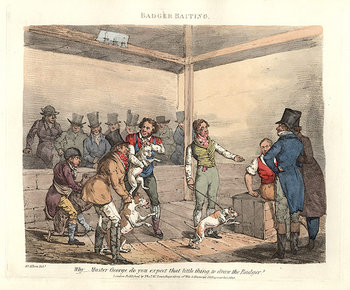|
From Wikipedia the free encyclopedia, by MultiMedia |
 Badger Baiting
Badger BaitingBadger-baiting is a bloodsport involving the baiting of badgers.
The badger is a quiet and harmless creature in its own domain; however, when threatened it can possess invincible courage. Weighing up to thirty-five pounds when fully grown, badgers have an extraordinary dangerous bite, which it is willing to use recklessly when threatened. Showing itself to be a dangerous adversary for any Dog made it a sought after participant for the fighting pit.
In order to use the badger's ability to defend itself to test the Dog, artificial badger dens were built, captured badgers were put in them and then the Dog was set on the badger. The badger would be placed in a box, which was furnished in imitation of it den and from there a tunnel led upward. The owner of the badger puts his animal in the box. The timekeeper is equipped with a watch and the badger's owner releases the Dog for the fight. Whoever wants to pit his Dog against the badger let it slide into the tunnel. Usually the Dog is seized immediately by the badger and the Dog in turn grips the badger. Each bites, tears and pulls the other with all their might. The owner quickly pulls out the Dog by its tail with jaws clamped obstinately onto the badger. The two are separated and the badger is returned to its den. Then the Dog is sent back into seize the badger and it again drawn out with the badger. This scene is repeated over and over again. The more often a Dog is able to seize the badger within a minute, so that both can be pulled out together, the more it is up to the task and is considered game.
Drawing the badger soon became a very popular sideshow in the pit. It provided a new opportunity to win or lose money by betting. Drawing the badger thus became a permanent part of the fight in the pit. Baits were staged outside the pit in cellars or taverns, as an interesting attraction for the guests.
The primary Dog used for badger-baiting is the Terrier. Specific Dog breeds were developed for badger-baiting, including but not limited too, the following: Airedale terrier, Bedlington Terrier, Blue Paul Terrier, Daschund, Fox Terrier, Glen of Imaal Terrier, Kerry Blue Terrier, Portuguese Podengo, Sealyham Terrier, Staffordshire Bull Terrier, Welsh Terrier, and Wheaten Terrier.
Strict Irish Kennel Club rules governed the Teastas Mor (certificate of gameness). It was considered that the discipline ensured contests between Dog and badger were fair. In the past, to become an Irish Kennel Club terrier champion, it was necessary for a terrier to be in possession of a Teastas Mor. These continued until the kennel ceased to license trials in 1968.
In addition, there were many other badger clubs; each had their own rules, which varied considerably. Frequently, the badger was afforded little protection.
Dogs, made by MultiMedia | Free content and software
This guide is licensed under the GNU Free Documentation License. It uses material from the Wikipedia.